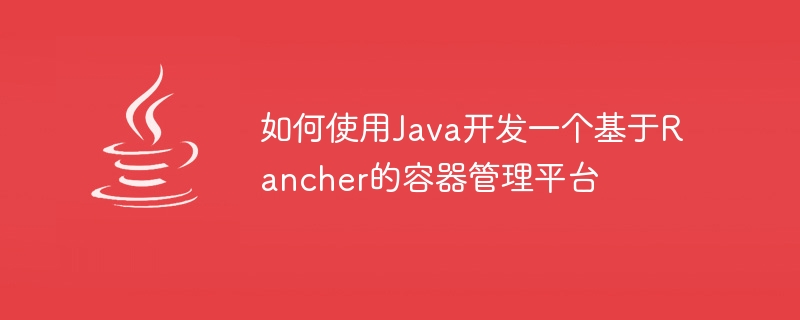
How to use Java to develop a container management platform based on Rancher
With the widespread application of container technology, container management platforms have become an important part of software development and deployment. . Rancher is a very popular container management platform that provides rich functions and a user-friendly interface to facilitate developers to manage and deploy containers.
In this article, I will introduce how to use Java to develop a Rancher-based container management platform, and provide specific code examples to help readers get started quickly.
Step One: Environment Preparation
First, make sure you have installed the Java development environment (JDK) and Maven. At the same time, the latest versions of Docker and Rancher need to be installed. You can download and install Rancher Server from the Rancher official website.
Step 2: Create a Maven project
Use Maven to create a new Java project. Add the following dependency in the project's pom.xml file:
This dependency will help us interact with the Rancher API.
Step 3: Connect to Rancher
In the Java code, we need to connect to Rancher Server. Create a new RancherClient instance and set the relevant parameters:
import io.rancher.Rancher;
import io.rancher.RancherClient;
import io.rancher.base.TypeCollection;
import io.rancher.service.StackService;
import io.rancher.service.HostService;
import io.rancher.service.ServiceService;
import io.rancher.service.ContainerService;
// . ..
String rancherUrl = "http://your-rancher-url/v2-beta";
String accessKey = "your-access-key";
String secretKey = "your-secret-key ";
RancherClient rancherClient = Rancher.createClient(rancherUrl, accessKey, secretKey);
StackService stackService = rancherClient.type(StackService.class);
HostService hostService = rancherClient.type(HostService.class );
ServiceService serviceService = rancherClient.type(ServiceService.class);
ContainerService containerService = rancherClient.type(ContainerService.class);
This code will create a RancherClient instance and use the provided access key and URL for verification.
Step 4: Operate Rancher resources
Using RancherClient instances can perform a variety of operations, including managing Stack, Host, Service, Container and other resources. The following are some common operation examples:
Stack stack = new Stack();
stack.setName("my- stack");
stack = stackService.create(stack).execute().body();
TypeCollection stacks = stackService.list().execute().body();
for(Stack stack : stacks.getData()) {
System.out.println(stack.getId() );
}
Service service = new Service();
service.setName("my-service" );
service = serviceService.create(service).execute().body();
Container container = new Container();
container.setName("my-container");
container.setImageUuid("docker:nginx");
container.setServiceId(service.getId());
container = containerService.create(container).execute().body();
Step 5: Compile and run
After completing the above steps, use Maven to compile the code and run the application. Make sure your Rancher Server is running properly and that access keys and URL parameters are set correctly.
Summary
This article introduces how to use Java to develop a Rancher-based container management platform. Using Rancher's Java client library, we can easily connect to Rancher Server and operate various resources. I hope this article can help readers quickly get started using Rancher for container management.
It should be noted that the code examples provided in this article are for illustration purposes only and do not cover all possible situations. In actual projects, it is recommended to have an in-depth understanding of the usage of Rancher API and the needs of specific scenarios in order to better use this powerful container management platform.
The above is the detailed content of How to use Java to develop a Rancher-based container management platform. For more information, please follow other related articles on the PHP Chinese website!